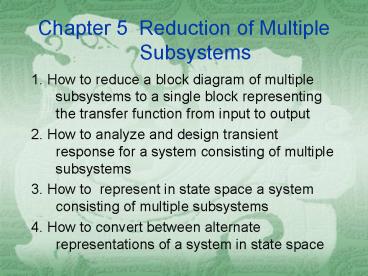Chapter 5 Reduction of Multiple Subsystems - PowerPoint PPT Presentation
1 / 19
Title:
Chapter 5 Reduction of Multiple Subsystems
Description:
Block diagrams are usually used for frequency-domain analysis and design. ... Design the value of gain, K, for the feedback control system ... – PowerPoint PPT presentation
Number of Views:639
Avg rating:3.0/5.0
Title: Chapter 5 Reduction of Multiple Subsystems
1
Chapter 5 Reduction of Multiple Subsystems
- 1. How to reduce a block diagram of multiple
subsystems to a single block representing the
transfer function from input to output - 2. How to analyze and design transient response
for a system consisting of multiple subsystems - 3. How to represent in state space a system
consisting of multiple subsystems - 4. How to convert between alternate
representations of a system in state space
2
Block diagram
Block diagrams are usually used for
frequency-domain analysis and design. The block
diagram representation of the system
relationships is prevalent in control system
engineering. Block diagrams consist of
unidirectional, operational blocks that
represent the transfer function of the
subsystems. In addition blocks and unidirectional
lines, there are some elements, such as Summing
junctions and pickoff points in the block diagram.
3
Figure 5.3a. Cascaded subsystemsb. equivalent
transfer function
Figure 5.5a. Parallel subsystemsb. equivalent
transferfunction
4
Figure 5.6a. Feedback controlsystemb.
simplified modelc. equivalent transferfunction
5
Figure 5.7Block diagramalgebra for
summingjunctionsequivalent forms for moving a
blocka. to the left past asumming junctionb.
to the right past asumming junction
6
Figure 5.8Block diagram algebra for pickoff
pointsequivalent forms for moving a blocka. to
the left past a pickoff pointb. to the right
past a pickoff point
7
Figure 5.9Block diagram for Example5.1
8
Figure 5.10Steps in solvingExample 5.1a.
collapse summingjunctionsb. form
equivalentcascaded systemin the forward
pathand equivalentparallel system in
thefeedback pathc. form equivalentfeedback
system andmultiply by cascadedG1(s)
9
Figure 5.11Block diagram for Example 5.2
10
Figure 5.12Steps in the block diagram
reduction for Example 5.2
11
Design the value of gain, K, for the feedback
control systemshown in the following block
diagram so that the system will respond with a
10 overshoot
Figure 5.16Feedback system
12
Signal-flow graphs
A signal-flow graph consists only of branches,
which represent systems, and nodes, which
represent signals.
Figure 5.17Signal-flow graph componentsa.
systemb. signalc. interconnection of systems
and signals
13
Figure 5.19Signal-flow graphdevelopmenta.
signal nodesb. signal-flow graphc. simplified
signal-flow graph
14
Masons Rule
- Definitions
- Input node An input node is a node that has only
outgoing branches. - Output node An output node is a node that has
only incoming branches. - Loop gain The product of branch gains found by
traversing a path that - starts at a node and ends at the same node,
following the direction of the signal flow,
without passing through any other node more than
once. - Forward-path gain The product of gains found by
traversing a path fro the input node to the
output node of the signal-flow graph in the
direction of signal flow. - Nontouching loops Loops that do not have any
nodes in common. - Nontouching-loop gain The product of loop gains
from nontouching loops taken two, three, four, or
more at a time.
15
Masons Rule The transfer function of a system
represented by a signal-flow graph is where
number of forward paths the
kth forward-path gain 1- loop
gains nontouching-loop gains taken two at
a time - nontouching-loop gains
taken three at a time nontouching-
loop gains taken four at a time -
loop gain terms in that
touch the kth forward path.
16
Figure 5.20Signal-flow graphfor
demonstratingMasons rule
17
Figure 5.21Signal-flow graph for Example 5.7
18
Signal-flow graph of state equations
Figure 5.22Stages ofdevelopment of
asignal-flow graphfor the system ofEqs.
5.36a. place nodesb. interconnectstate
variables andderivativesc. form dx1/dt d.
form dx2/dt(figure continues)
19
Similarity Transformations
- The transformation is called a similarity
transformation, since in the - transformed system such properties as the
characteristic equation, - eigenvectors, eigenvalues, and transfer function
ar all preserved by - the transformation.
- where is a transformation matrix.































